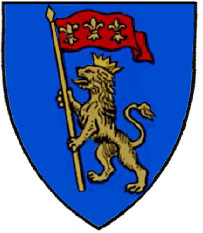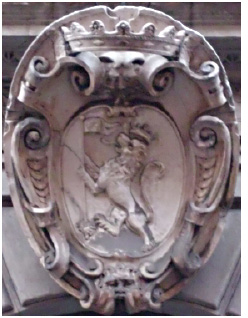...Best of Sicily presents... Best of Sicily Magazine. ... Dedicated to Sicilian art, culture, history, people, places and all things Sicilian. |
by Vincenzo Salerno | ||
Magazine Index Best of Sicily Arts & Culture Fashion Food & Wine History & Society About Us Travel Faqs Contact Map of Sicily |
A certain William Branciforte, who died in Catania in 1347, wed Francesca, daughter of Manfred Maletta. Manfred was feudal lord of Mineo, in eastern Sicily, and by right of marriage to Francesca William became his feudal heir. The Constitutions of Melfi of Frederick II had established that in the Sicilian feudal system daughters could succeed to their fathers if male heirs were lacking out to a certain degree of kinship - a practice which in subsequent centuries came to be called Sicilian Succession. However, though the ancient city was an early jewel in the Branciforte crown, William was already rich enough without it. By 1600, the Branciforte had come into possession of a number of feudal towns and estates across Sicily, including Butera, Leonforte, Niscemi, Pietraperzia, Scordia, Villanova (all princedoms); San Giovanni, Santa Lucia and the eponymous Branciforte (dukedoms); Barrafranca, Martini, Militello (marquisates); Sant'Antonio, Cammarata, Mazzarino, Raccuia (counties); and a number of baronies, among which Belmonte, Cassibile, Condrò, Daini, Gallitano, Gallizzi, Malfitano, Melilli, Mirto, Motta Camastra, Radalì, Sinagra, Tavi, Ursitto and Voltano.
The connection with the Abbatellis family is interesting. Late in the fifteenth century, the Abatellis ran out of male heirs, so the young Margherita Abbatellis Branciforte was betrothed to her uncle, Federico Branciforte, to keep the wealth in the family. This Federico became, by right of his wife, the count of Cammarata in 1503. Apart from this incestuous union with his niece, Federico Branciforte was by most accounts an unsavoury, disloyal character motivated by avarice. He conspired against the viceroy, Ugo Moncada, and following trial was executed for his treachery. This left Margherita single and again an heiress. She wed another Branciforte, Blasco, by whom she bore a son. Today the Abbatellis blood is preserved in their descendants, but the Branciforte family itself no longer exists in the male line, the Lanza di Trabia being their heirs. The extinction of the Branciforte family occurred through the simple absence of male heirs. One of the last prominent Brancifortes was Nicolò, prince of Leonforte, senator of Palermo in 1799 and again in 1803. His only surviving child, a daughter, inherited all the Branciforte titles and lands. She wed Giuseppe Lanza, a distant cousin, thus keeping the familial property "in the family" but without the Branciforte name except occasionally added to that of the male line as "Lanza Branciforte." About the Author: Palermo native Vincenzo Salerno has written biographies of several famous Sicilians, including Frederick II and Giuseppe di Lampedusa. This article is the second in our Historic Families series. | |
Top of Page |
 Branciforte (sometimes Branciforti)
literally means "strong claw,"
something appropriately reflected in the lion's paws in the family's coat
of arms. The fleurs de lis in the banner allude to the family's Frankish
sympathies in earlier times. The lion bears a banner because the Branciforte
progenitor, thought to be a certain Obitz or Obizzo, is said to have served
as the flag bearer of Charlemagne in the wars against the Longobards. True
or not, the legend has a nice ring to it, Obizzo represented as a fierce
beast loyal to his king.
Branciforte (sometimes Branciforti)
literally means "strong claw,"
something appropriately reflected in the lion's paws in the family's coat
of arms. The fleurs de lis in the banner allude to the family's Frankish
sympathies in earlier times. The lion bears a banner because the Branciforte
progenitor, thought to be a certain Obitz or Obizzo, is said to have served
as the flag bearer of Charlemagne in the wars against the Longobards. True
or not, the legend has a nice ring to it, Obizzo represented as a fierce
beast loyal to his king. Among the earliest
members of the family in Sicily were Stephen
and his son Raphael, the latter becoming the first baron of Mazzarino and
a high-ranking royal representative in eastern Sicily. The matrimonial alliances
continued over time, and so did the royal appointments. In 1374 Raphael's
son, Giovanni, was a commander of the royal armies during a time when professional
cavalry and infantry units began - if slowly - to supplant knights and part-time
archers as defenders of the kingdom.
Among the earliest
members of the family in Sicily were Stephen
and his son Raphael, the latter becoming the first baron of Mazzarino and
a high-ranking royal representative in eastern Sicily. The matrimonial alliances
continued over time, and so did the royal appointments. In 1374 Raphael's
son, Giovanni, was a commander of the royal armies during a time when professional
cavalry and infantry units began - if slowly - to supplant knights and part-time
archers as defenders of the kingdom.